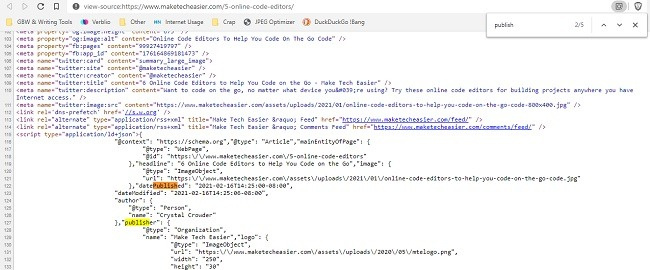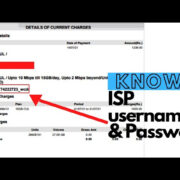Discovering the publication date of a webpage can be crucial for various reasons—whether you’re conducting research, verifying information, or simply satisfying curiosity. However, webpages do not always include a clear publication date. Fortunately, there are effective methods and techniques you can apply to uncover this often elusive piece of data. In this guide, we will explore a variety of strategies to help you ascertain when a webpage was first made available on the internet.

Inspect Page Source
Each webpage is built with code that your browser reads to display content. Sometimes, the publication date is embedded within this code.
- Open the webpage: Navigate to the webpage you are interested in.
- Access the source code: Right-click on the webpage and select “View Page Source” or press
Ctrl+U(Command+Option+U on Mac). - Search for the date: Press
Ctrl+F(Command+F on Mac) to open the search box and type in keywords such as “datePublished”, “article:published_time”, or simply “date” to find the timestamp.
Summary: Inspecting the page source is a straightforward method that can be highly accurate. However, not all webpages will have this information readily available or easily readable for those without technical experience.
Use Social Media
Some webpages are shared on social media platforms with a timestamp indicating when they were published.
- Search for the webpage on social media: Use platforms like Twitter or Facebook to search for the URL of the webpage.
- Identify the share date: Look for the first instance the webpage was shared to approximate the publish date.
Summary: This method can provide a rough estimate of the publication date. The downside is that it assumes the page was shared soon after being published and thus might not always be accurate.
Check Archived Versions
Web archiving services like the Wayback Machine store copies of webpages over time.
- Visit the Wayback Machine: Go to archive.org/web/.
- Enter the webpage URL: Type the URL of the webpage into the search bar and hit enter.
- Explore the timeline: Browse through the calendar to find the earliest snapshot, which often correlates with the publish date.
Summary: This is a useful method for locating the publication date, though it assumes the page was archived shortly after publication. Some pages may not be archived immediately, however, which could lead to an incorrect date.
Look at the Sitemap
Webmasters use sitemaps to list the pages available on a website, sometimes including publication dates.
- Find the sitemap: Scroll to the bottom of the website to find a link to the sitemap or type “/sitemap.xml” after the main URL.
- Search for the webpage: Use the browser’s search function to find the webpage in the sitemap document.
- Examine the date: If available, check for a
<lastmod>tag next to the webpage listing, which might indicate the publication or last modified date.
Summary: This solution can be very helpful, although not all sitemaps include publication dates, and the <lastmod> date can sometimes reflect a recent update rather than the original publish date.
Contact the Website Owner
Reaching out directly to the person or team responsible for the webpage can yield accurate results.
- Locate the contact information: Search the website for a “Contact Us” page or similar sections with email addresses.
- Draft a polite inquiry: Compose a polite email asking for the publication date of the specific webpage.
- Send your request: Send the email and wait for a response from the website owner or team.
Summary: This method can provide an authoritative answer, but response times can be slow or non-existent depending on the website’s owner.
Use a Google Search Query
Google sometimes indexes the publication date, which can be viewed through a specific search query.
- Google the webpage: Start by performing a search for the webpage in question.
- Use search tools: Click on “Tools” under the search bar and then “Any time” to drop down a menu that lets you filter results by time.
- Look at the results: Check under the search results where Google sometimes displays the date.
Summary: Google’s index might reveal the publication date, but this isn’t always reliable as some webpages aren’t indexed immediately upon publication, and dates might not always be displayed.
Examine the URL Structure
Some websites include the date within the URL of the webpage.
- Look at the webpage URL: Observe the URL to see if it contains a series of numbers that could represent a date format (e.g., 2023/03/15 for March 15, 2023).
- Decipher the date: If the structure seems to represent a date, it could very well be the publication date.
Summary: While this can be a quick indicator, not all websites use this structure and sometimes the numbers might be misleading or represent something other than a date.
Observe Copyright Information
At the bottom of a webpage, there’s often copyright information that can give clues to the publish date.
- Scroll to the webpage footer: Look for any text towards the bottom of the page.
- Find the copyright date: This is often listed with a symbol and can indicate the earliest content publication time.
Summary: Although this can give you a ballpark figure, it does not necessarily reflect when the specific webpage was published and might only show when the website was first created or the content was copyrighted.
Analyze Metadata with Tools
Certain online tools can extract metadata from the webpage, including potential publication dates.
- Find a metadata analysis tool online: Websites such as BuiltWith or Hexometer offer such tools.
- Enter the URL: Submit the webpage URL for analysis.
- Review the results: Look for any dates in the webpage’s metadata that could indicate publication time.
Summary: These tools can be very useful, though the accuracy of the results can vary, and non-technical users may find interpreting the data challenging.
Review Article Content
Sometimes the content of the webpage itself may have references to dates or events that can help pinpoint a publication time frame.
- Read the article thoroughly: Look for any dates mentioned in the text.
- Analyze the context: Determine if these dates are tied to the content release or an event discussed within the article.
Summary: This is more of a deductive approach and may not supply a precise publication date. It does, however, serve as an additional clue when other methods fall short.
In conclusion, while there is no one-size-fits-all solution to finding out when a webpage was published, a combination of the methods outlined above can offer a solid estimate. Some tactics involve examining webpage metadata or archived versions, while others require reaching out directly to the content creators. Regardless of the approach, persistence and attention to detail will serve you well in your quest to discover a webpage’s publication date.
FAQs
Q: What is the easiest way to find out when a webpage was published?
A: The easiest way could be to search the page source for a publication date or to use social media to find the first time the page was shared.
Q: Can I trust the publication date provided by search engine results?
A: Search engine results often provide a date, which can be a useful indicator, but it is not always accurate. Cross-reference with other methods for best results.
Q: Is it possible that some webpages may not have any discoverable publication date?
A: Yes, it is possible. In some cases, publication dates are not recorded or shared publicly, making it difficult or impossible to find an exact date.








